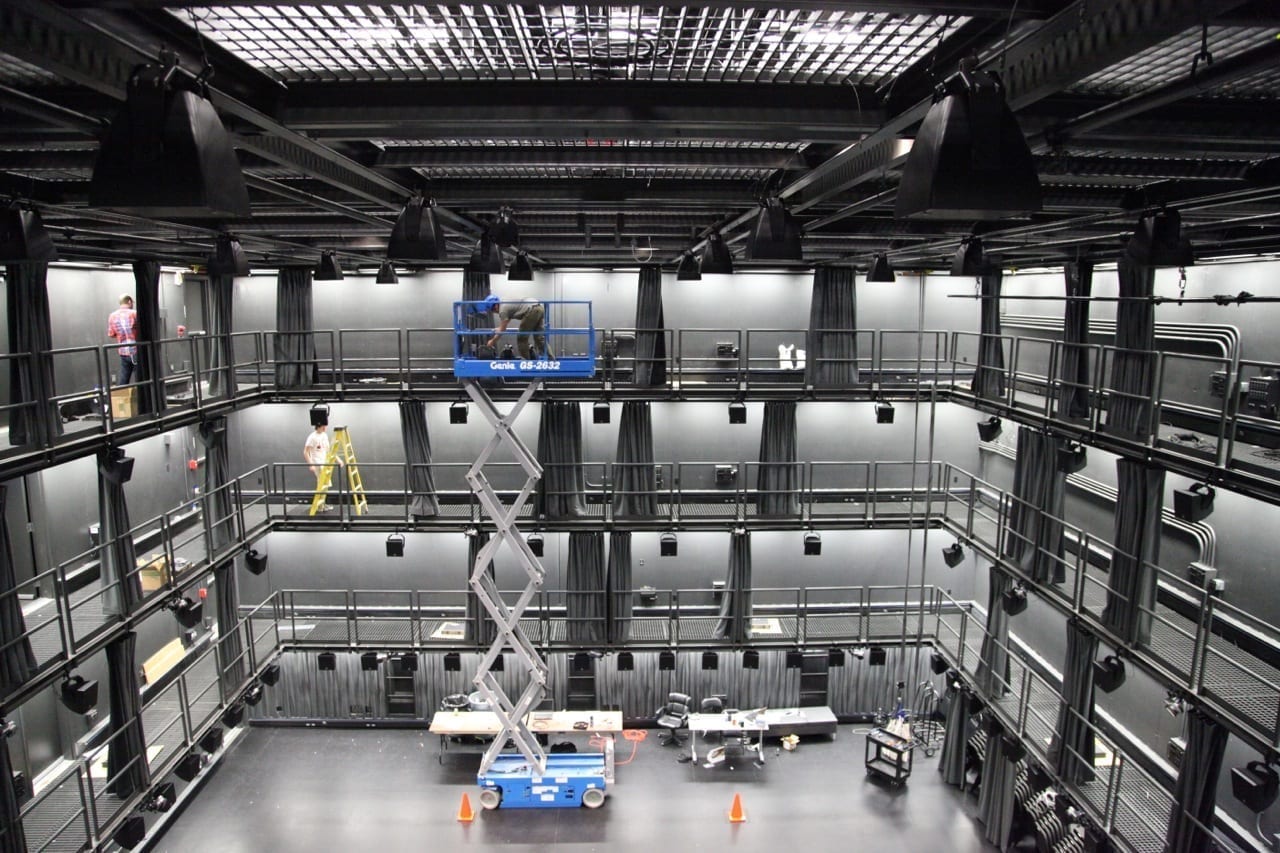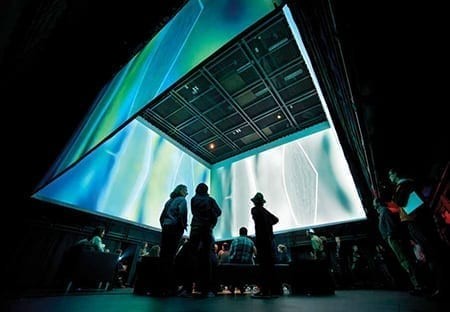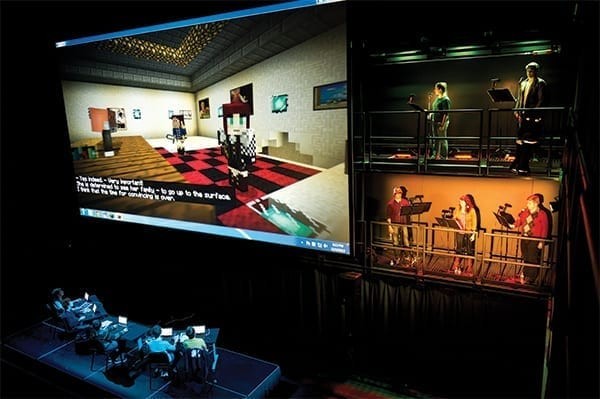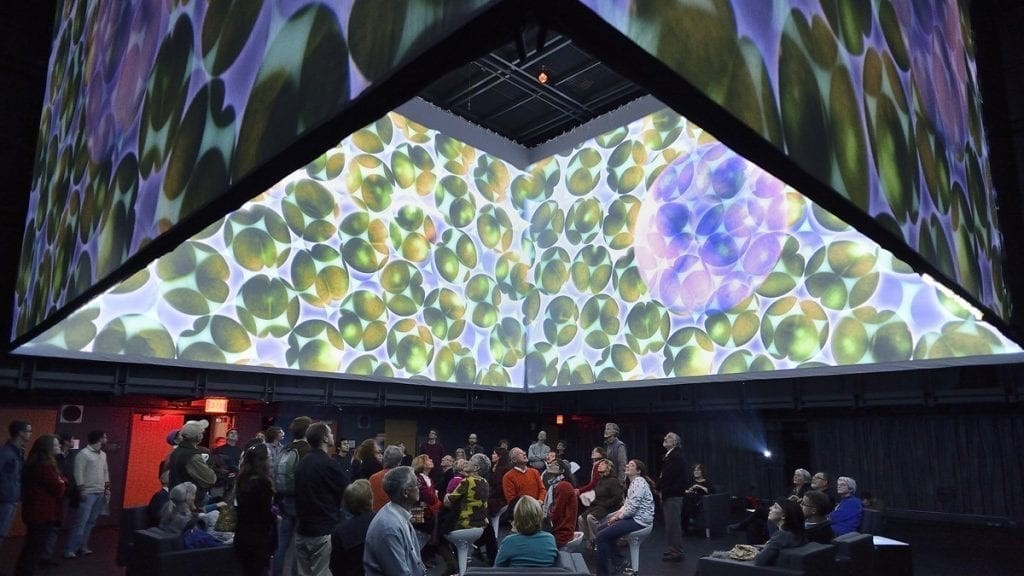The Cube Drives Immersive 3D Audio Experiences with Flexible Dante Network

Center of the Arts at Virginia Tech, Blacksburg, VA United States



Description
The Center for the Arts at Virginia Tech presents programs that transform lives through exploration and engagement with the arts and the creative process. A significant part of this experience is The Cube, a unique, four-story, state-of-the-art Theater and high tech laboratory that serves multiple platforms of creative practice by faculty, students, and guest artists and researchers from around the world. The Cube is a highly adaptable space for research and experimentation in data exploration, immersive environments, intimate performances, audio and visual installations, and experiential investigations, boasting one of the world’s highest channel-count 3D audio systems.
Shared between the University’s Center for the Arts and the Institute of Creativity, Arts and Technology (ICAT), The Cube integrates some of the world’s most cutting-edge technology to enable synchronized data capture, real-time audio/visual rendering and immersive 3D audio experiences, including wave field synthesis and holosonic sound display interaction. The facility-wide professional AV capabilities are particularly important for artistic installations and performances, with large multi-screen video displays, 128 loudspeakers, and a robust, multichannel Dante network to accomplish the goal of complete immersion.
Challenge
During the design phase, the Cube’s unusual dimensions (50’ w x 40’l x 32’h) and high loudspeaker count ignited discussions about how to effectively move and control audio around the facility. The Cube’s highly adaptable space required an audio distribution solution with extensive reach and a highly flexible architecture to ensure creative freedom across a multitude of projects. Tanner Upthegrove, the media engineer at ICAT and lead systems integrator for The Cube, joined forces with Denis Blount of ARUP, a consulting firm that specializes in cutting-edge AV design, to address this challenge.
“The Cube is different from other facilities because it’s built like a traditional black box theater, but often used for heavy-duty scientific and next-generation research that’s collaborative in nature,” said Upthegrove. “We needed a robust infrastructure to support everything we set out to accomplish in this facility. Denis did the architectural heavy lifting, producing logical drawings and suggesting products to evaluate. We started by running Gigabit Ethernet across the facility, with fiber analog audio and digital video connections throughout.”
The discussion turned toward effective audio networking as loudspeaker and amplifier testing progressed. Along with Denis and the ARUP team, Upthegrove’s colleague Rob Ganier suggested Dante would cost-efficiently address the requirement for reliable audio networking across a large spatial audio installation. Following various networking technology evaluations, the team confirmed that Dante would offers faculty, students and visiting artists and researchers the freedom to work at any position in The Cube.
“Rob insisted on Dante based on his experience with this technology versus other networking solutions,” said Upthegrove. “It was clear after initial tests that Dante was the easiest networking solution to use. Dante is agnostic for the user, so most contributors can use the network with either network-enabled hardware or the Dante Virtual Sound Card on a computer. That’s very important here since we aren’t always aware who might come into the facility and plug into the system.”
Solution
The decision to install a Dante network influenced Upthegrove toward Yamaha XMV 82 ADD amplifiers, which can drive eight speakers from a single Dante connection. Upthegrove calls this selection a natural fit, given the high sound quality of the Yamaha amplifier and its Dante-enabled multichannel capability. The system also includes Dante-enabled BSS BLU 806 digital signal processors, which allow users to effortlessly route signals across any location in The Cube.
Denis Blount, acoustic and AV designer at ARUP, played an instrumental role in developing a network infrastructure that would allow a wide variety of users to plug in laptops and connected devices, and use their choice of software DAW systems to push audio out into the spatial audio domain. Blount says that Dante was a natural fit for the Gigabit Ethernet infrastructure put into place. Importantly, that infrastructure did not have to be supplemented to implement Dante, reducing complexity across the board.
“The luxury of working across a space of this size is that we had the freedom to create a unique, high-capacity immersive audio system, so we were looking for maximum flexibility and scalability at a low price point,” said Blount. “Dante was the obvious choice compared to other networking solutions. We could use the switches and Cat6 cabling that were in place, and it gave us the ability patch and reconfigure on the soft side as required. The team at The Cube do not have to do much on the physical side moving forward. That buys them a lot of future flexibility, and keeps their total cost of ownership very low over time.”
Upthegrove also emphasizes the cost-reducing benefits – notably requiring only 15 percent the amount of copper wiring that an all-analog installation would need – as well as scalability, with Dante enabling nearly limitless possibilities moving forward.
“The Dante network and its corresponding hardware reduces the costs and labor of buying and running cable, and eliminates separate converters and peripheral equipment that would otherwise drive up expenses,” said Upthegrove. “What’s exciting to me as an installer is that I don’t have to run analog cable to 128 speakers from an amp room. I’m installing the amps at the speaker locations so that I have a 10-foot average cable run for speakers. We’re using off-the-shelf networking components to fuel the topology, which is very convenient and inexpensive.
“One of the main reasons we chose Dante was because we started out with 145 audio channels, but we’re definitely going to add more in the future,” he continued. “With Dante, it’s as easy as plugging a device into the switch and adding another Dante soundcard. Just like that there are dozens of additional channels. It’s very simple, and we’re well-prepared for future expansion.”
Benefits and Savings
- Flexibility to route audio to and from any location on the network
- Leverages existing switches, Cat6 cabling and off-the-shelf components to simplify deployment
- Multichannel capability supports high channel counts for delivery across multiple loudspeakers
- Eliminates additional hardware, minimizes cable and reduces labor for overall cost reduction
- Limitless scalability of the Dante network for future needs
Dante Media Networking Drives Immersive 3D Audio Experiences at Virginia Tech



